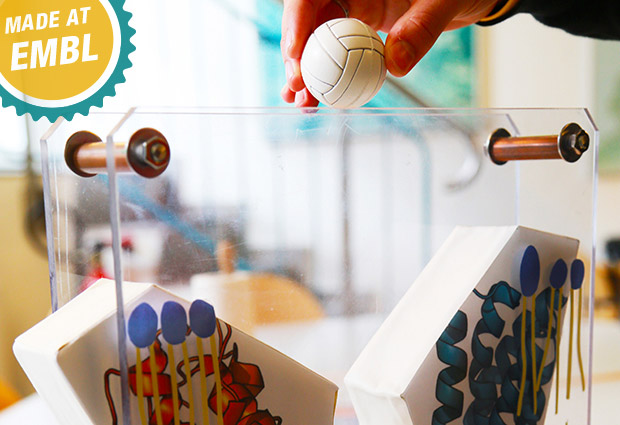
A whole new ball game
In preparation for this year’s Night of Science Event in Hamburg on 7 November, members of the Löw group have designed and constructed a game to explain and demonstrate how proteins can transport molecules across a cell membrane. Yonca Ural-Blimke explains how they went about it, in the first in the 'Made at EMBL' series.


What does the game demonstrate?
Transporter proteins are anchored in, and span the entire depth of cell membranes – as the name suggests, they move molecules from one side of the membrane to the other. There are several different types of transporter proteins and mechanisms for moving molecules. We study proton-dependent oligopeptide transporters – POT for short – that move the products of digestion and certain drugs. POT proteins consist of two bundles that combine in different formations to carry molecules across the membrane. This game demonstrates the ‘alternating access mechanism’, whereby access by the molecule (the ball) is first into the protein, and then out into the cell once the first access point is closed.
Tell us more…
The central part of the game is a model of the transporter protein embedded within a cell membrane: the two POT bundles are represented by two polystyrene blocks positioned between plexiglass sheets decorated to represent the cell membrane. The aim of the game is to throw a small ball into the model, making the two parts of the protein move apart to let the ball cross the membrane.
How did you design and build the game?
We started playing around with the idea for EMBL’s Lab Day, and discussed with various people about how to build it: How could we get two parts to move? What transparent but sturdy material could we use? After some brainstorming, I presented our idea to Mechanical Technician Doris Jahn and asked if she could help – fortunately, she said yes! We went through the workshop together and picked out some materials to test. I originally planned to build the game at home, but quickly learned that it was important to have access to the right cutting tool; moreover, the hands-on preparation of the game together with Doris in the workshop was lots of fun! An important consideration was the final size: big enough to see, but small enough to safely transport and use.
An important consideration was the final size: big enough to see, but small enough to safely transport and use.
What was the most challenging part of the design?
One of the hardest issues to solve was how to get the two parts of the protein to stay in the correct conformation – it wasn’t really clear until the final day how to get around it. We considered using springs to keep the parts on one side together and on the other apart, but that is surprisingly hard to get right while not obstructing the ball. The trick was to add a weight – a metal bar – to the bottom corner of the polystyrene, to keep it in the right orientation. The decorations were also fiddly and time consuming – I printed them using modelling software and yes, they are images of the real proteins!
How are you refining the game?
We initially planned that people should stand about three steps back and attempt to throw balls into the transporter – anyone who successfully landed three from six balls would be listed in a Hall of Fame. At Lab Day, this turned out to be an impossible task, so people just kept throwing until they got one ball in. We ended up with many names on the poster, and it created a playful, cheerful atmosphere. For younger players we will set an easier distance and a more achievable goal. In the future, we could decorate the balls with different chemical formulas so players can choose which molecule to add. Less bouncy balls may also improve gameplay – I visited numerous toyshops to find the right size and weight, asking “Do you have something like this but heavier? Or like this but smaller?” No one ever said scientific enquiry was easy!


